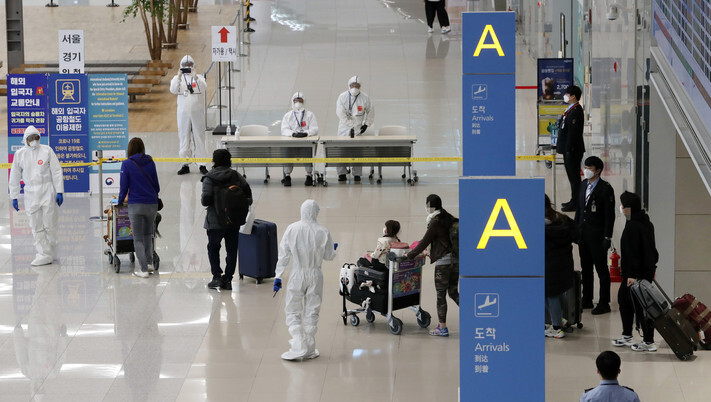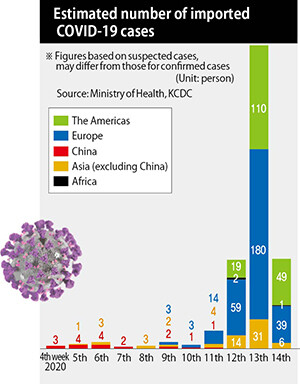hankyoreh
Links to other country sites 다른 나라 사이트 링크
Seoul Capital Area sees twice as many new COVID-19 cases as Daegu and N. Gyeongsang

The novel coronavirus has been spreading at a disturbing rate in South Korea’s densely populated Seoul Capital Area. There are indications that, over the past two weeks, the transmission epicenter has been shifting to the capital area from its former location in Daegu and North Gyeongsang Province. The government has announced the need to keep strict social distancing policies in place beyond the original date of Apr. 5.
The South Korean Centers for Disease Control and Prevention (KCDC) announced on Apr. 1 that 101 more cases of COVID-19 had been reported the previous day. More than half of those cases occurred in the Seoul Capital Area (SCA), with 24 cases in Seoul, 23 in Gyeonggi Province, and five in Incheon. In short, there were twice as many new cases in the SCA as in Daegu (20) and North Gyeongsang Province (two).

With about a hundred new COVID-19 cases being reported each day over the past three weeks, the SCA is exhibiting a sharp increase in cases. Prior to Mar. 18, there were 270 cases in Seoul, 277 in Gyeonggi Province, and 32 in Incheon, for a total of 579 in the SCA. In just two weeks, that number has nearly doubled, to 1,042 (not including patients at the quarantine center at Incheon Airport). As of Apr. 1, 474 cases had been reported in Seoul, 499 in Gyeonggi Province, and 69 in Incheon.
“More than 70% of people arriving from outside of the country reside in the Seoul Capital Area ,” said KCDC Director Jung Eun-kyeong on Wednesday. According to Jung, that’s one factor behind the growing number of cases in Seoul, Gyeonggi Province, and Incheon. The SCA accounts for the majority of the places where the 336 imported cases of COVID-19 had occurred as of Wednesday. (There are actually 560 imported cases altogether, but this figure disregards the 224 diagnosed at the airport’s quarantine center.) Seoul accounted for the largest number of imported cases, at 127, followed by Gyeonggi Province at 96 and Incheon at 25.
Another reason why COVID-19 is still spreading is the continuing occurrence of transmission clusters at medical facilities and churches in the SCA. As of 10 am on Wednesday, there were 478 cases of COVID-19 in the Seoul region, up 28 from the previous day. Particularly striking were the additional cases reported at Manmin Central Church, in the Guro district of Seoul. A total of 41 cases are linked to the church, up eight from the day before. The number of cases originating overseas is also steadily increasing, with 16 more imported cases reported on Wednesday.
The disease is also still spreading at hospitals. After two COVID-19 cases were reported on Mar. 29-30 at Uijeongbu St. Mary's Hospital, affiliated with the Catholic University of Korea, in Gyeonggi Province, eight more cases (affecting nurses, caregivers, and cleaning staff) were diagnosed on Mar. 31 and two more on Apr. 1. That brings the current tally of cases at the hospital to 12, as of 4 pm on Wednesday. In addition to cases inside the hospital, there has also been second-generation spread of COVID-19, including three sisters who were taking care of their mother, who was hospitalized there.
“The number of patients by itself cannot be taken as the criterion for switching to quarantine measures that are more suited to our daily routines. The timeframe of that transition must be decided based on whether new cases are being managed inside our disease control network, whether we’re able to ascertain the modes of transmission, and whether it’s at a level that we can handle,” Jung said.
“Given the continuing influx of cases from overseas and the rapid increase of cases around the world, there are still considerable hurdles to relaxing our social distancing measures,” said Kim Gang-lip, first general coordinator of the Central Disaster and Safety Countermeasures Headquarters.
By Chai Yoon-tae, staff reporter
Please direct comments or questions to [english@hani.co.kr]

Editorial・opinion
![[Column] Life on our Trisolaris [Column] Life on our Trisolaris](https://flexible.img.hani.co.kr/flexible/normal/500/300/imgdb/original/2024/0505/4817148682278544.jpg) [Column] Life on our Trisolaris
[Column] Life on our Trisolaris![[Editorial] Penalties for airing allegations against Korea’s first lady endanger free press [Editorial] Penalties for airing allegations against Korea’s first lady endanger free press](https://flexible.img.hani.co.kr/flexible/normal/500/300/imgdb/original/2024/0502/1817146398095106.jpg) [Editorial] Penalties for airing allegations against Korea’s first lady endanger free press
[Editorial] Penalties for airing allegations against Korea’s first lady endanger free press- [Editorial] Yoon must halt procurement of SM-3 interceptor missiles
- [Guest essay] Maybe Korea’s rapid population decline is an opportunity, not a crisis
- [Column] Can Yoon steer diplomacy with Russia, China back on track?
- [Column] Season 2 of special prosecutor probe may be coming to Korea soon
- [Column] Park Geun-hye déjà vu in Yoon Suk-yeol
- [Editorial] New weight of N. Korea’s nuclear threats makes dialogue all the more urgent
- [Guest essay] The real reason Korea’s new right wants to dub Rhee a founding father
- [Column] ‘Choson’: Is it time we start referring to N. Korea in its own terms?
Most viewed articles
- 1New sex-ed guidelines forbid teaching about homosexuality
- 2OECD upgrades Korea’s growth forecast from 2.2% to 2.6%
- 360% of young Koreans see no need to have kids after marriage
- 4[Column] Life on our Trisolaris
- 5Months and months of overdue wages are pushing migrant workers in Korea into debt
- 6Korean government’s compromise plan for medical reform swiftly rejected by doctors
- 7[Guest essay] Maybe Korea’s rapid population decline is an opportunity, not a crisis
- 8S. Korea discusses participation in defense development with AUKUS alliance
- 9Presidential office warns of veto in response to opposition passing special counsel probe act
- 10Inside the law for a special counsel probe over a Korean Marine’s death